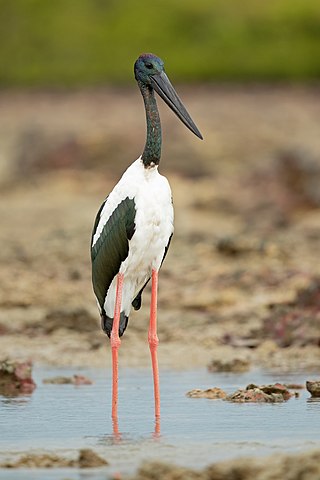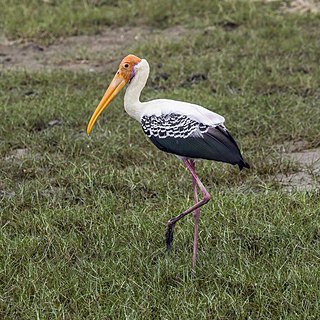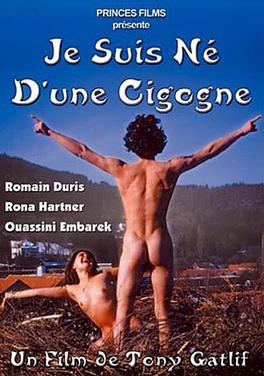This article needs additional citations for verification .(March 2019) |
| Christine and the Storks | |
|---|---|
| Directed by | Jirí Jahn |
Release date |
|
| Country | East Germany |
| Language | German |
Christine and the Storks is an East German film. It was released in 1962.
This article needs additional citations for verification .(March 2019) |
| Christine and the Storks | |
|---|---|
| Directed by | Jirí Jahn |
Release date |
|
| Country | East Germany |
| Language | German |
Christine and the Storks is an East German film. It was released in 1962.

Storks are large, long-legged, long-necked wading birds with long, stout bills. They belong to the family called Ciconiidae, and make up the order Ciconiiformes. Ciconiiformes previously included a number of other families, such as herons and ibises, but those families have been moved to other orders.

The shoebill, also known as the whalebill, whale-headed stork, and shoe-billed stork, is a large long-legged wading bird. It derives its name from its enormous shoe-shaped bill. It has a somewhat stork-like overall form and has previously been classified with the storks in the order Ciconiiformes based on this morphology. However, genetic evidence places it with pelicans and herons in the Pelecaniformes. The adult is mainly grey while the juveniles are more brown. It lives in tropical East Africa in large swamps from South Sudan to Zambia.
The white stork is a large bird in the stork family, Ciconiidae. Its plumage is mainly white, with black on the bird's wings. Adults have long red legs and long pointed red beaks, and measure on average 100–115 cm (39–45 in) from beak tip to end of tail, with a 155–215 cm (61–85 in) wingspan. The two subspecies, which differ slightly in size, breed in Europe, northwestern Africa, southwestern Asia and southern Africa. The white stork is a long-distance migrant, wintering in Africa from tropical Sub-Saharan Africa to as far south as South Africa, or on the Indian subcontinent. When migrating between Europe and Africa, it avoids crossing the Mediterranean Sea and detours via the Levant in the east or the Strait of Gibraltar in the west, because the air thermals on which it depends for soaring do not form over water.
The black stork is a large bird in the stork family Ciconiidae. It was first described by Carl Linnaeus in the 10th edition of his Systema Naturae. Measuring on average 95 to 100 cm from beak tip to end of tail with a 145-to-155 cm (57-to-61 in) wingspan, the adult black stork has mainly black plumage, with white underparts, long red legs and a long pointed red beak. A widespread but uncommon species, it breeds in scattered locations across Europe, and east across the Palearctic to the Pacific Ocean. It is a long-distance migrant, with European populations wintering in tropical Sub-Saharan Africa, and Asian populations in the Indian subcontinent. When migrating between Europe and Africa, it avoids crossing broad expanses of the Mediterranean Sea and detours via the Levant in the east, the Strait of Sicily in the center, or the Strait of Gibraltar in the west. An isolated, non-migratory, population occurs in Southern Africa.

The marabou stork is a large wading bird in the stork family Ciconiidae native to sub-Saharan Africa. It breeds in both wet and arid habitats, often near human habitation, especially landfill sites. It is sometimes called the "undertaker bird" due to its shape from behind: cloak-like wings and back, skinny white legs, and sometimes a large white mass of "hair".
The Asian woolly-necked stork or Asian woollyneck is a species of large wading bird in the stork family Ciconiidae. It breeds singly, or in small loose colonies. It is distributed in a wide variety of habitats including marshes in forests, agricultural areas, and freshwater wetlands across Asia.

The black-necked stork is a tall long-necked wading bird in the stork family. It is a resident species across the Indian Subcontinent and Southeast Asia with a disjunct population in Australia. It lives in wetland habitats and near fields of certain crops such as rice and wheat where it forages for a wide range of animal prey. Adult birds of both sexes have a heavy bill and are patterned in white and irridescent blacks, but the sexes differ in the colour of the iris with females sporting yellow irises and males having dark-coloured irises. In Australia, it is known as a jabiru although that name refers to a stork species found in the Americas. It is one of the few storks that are strongly territorial when feeding and breeding.

The painted stork is a large wader in the stork family. It is found in the wetlands of the plains of tropical Asia south of the Himalayas in the Indian Subcontinent and extending into Southeast Asia. Their distinctive pink tertial feathers of the adults give them their name. They forage in flocks in shallow waters along rivers or lakes. They immerse their half open beaks in water and sweep them from side to side and snap up their prey of small fish that are sensed by touch. As they wade along they also stir the water with their feet to flush hiding fish. They nest colonially in trees, often along with other waterbirds. The only sounds they produce are weak moans or bill clattering at the nest. They are not migratory and only make short-distance movements in some parts of their range in response to changes in weather or food availability or for breeding. Like other storks, they are often seen soaring on thermals.

The wood stork is a large American wading bird in the family Ciconiidae (storks), the only member of the family to breed in North America. It was formerly called the "wood ibis", although it is not an ibis. It is found in subtropical and tropical habitats in the Americas, including the Caribbean. In South America, it is resident, but in North America, it may disperse as far as Florida. Originally described by Carl Linnaeus in 1758, this stork likely evolved in tropical regions. The head and neck are bare of feathers, and dark grey in colour. The plumage is mostly white, with the exception of the tail and some of the wing feathers, which are black with a greenish-purplish sheen. The juvenile differs from the adult, with the former having a feathered head and a yellow bill, compared to the black adult bill. There is very little sexual dimorphism.

The saddle-billed stork or saddlebill is a large wading bird in the stork family, Ciconiidae. It is a widespread species which is a resident breeder in sub-Saharan Africa from Sudan, Ethiopia and Kenya south to South Africa, and in The Gambia, Senegal, Côte d'Ivoire and Chad in west Africa. It is considered endangered in South Africa.

Faye Margaret Emerson was an American film and stage actress and television interviewer who gained fame as a film actress in the 1940s before transitioning to television in the 1950s and hosting her own talk show.
Gilbert Stork was an organic chemist. For a quarter of a century he was the Eugene Higgins Professor of Chemistry Emeritus at Columbia University. He is known for making significant contributions to the total synthesis of natural products, including a lifelong fascination with the synthesis of quinine. In so doing he also made a number of contributions to mechanistic understanding of reactions, and performed pioneering work on enamine chemistry, leading to development of the Stork enamine alkylation. It is believed he was responsible for the first planned stereocontrolled synthesis as well as the first natural product to be synthesised with high stereoselectivity.

Stork Club was a nightclub in Manhattan, New York City. During its existence from 1929 to 1965, it became one of the most prestigious clubs in the world. A symbol of café society, the wealthy elite, including movie stars, celebrities, showgirls, and aristocrats all mixed in the VIP Cub Room. The club was established on West 58th Street in 1929 by Sherman Billingsley, a former bootlegger from Enid, Oklahoma. After an incident when Billingsley was kidnapped and held for ransom by Mad Dog Coll, a rival of his mobster partners, he became the sole owner of the Stork Club. It remained at its original location until it was raided by Prohibition agents in 1931 after which it moved to East 51st Street. From 1934 until its closure in 1965, it was located at 3 East 53rd Street, just east of Fifth Avenue, when it became world-renowned with its celebrity clientele and luxury. Billingsley was known for his lavish gifts, which brought a steady stream of celebrities to the club and also ensured that those interested in the famous would have a reason to visit.

Travis Lane Stork is an American television personality, emergency physician, and author best known for appearing on The Bachelor, and as the host of the syndicated daytime talk show The Doctors from 2008 to 2020.
Jeffrey Malcolm Stork is a former American volleyball player and coach. He is also a three-time Olympian. He was a member of the United States national teams that won the gold medal in the 1988 Summer Olympics and the bronze medal in the 1992 Summer Olympics, and also competed in the 1996 Summer Olympics. He is regarded as one of the best setters of all time, and was known to play well under pressure.
Stork is a 1971 Australian comedy film directed by Tim Burstall. Stork is based on the play The Coming of Stork by David Williamson. Bruce Spence and Jacki Weaver make their feature film debuts in Stork, being honoured at the 1972 Australian Film Institute Awards, where they shared the acting prize. Stork won the prize for best narrative feature and Tim Burstall won for best direction. Stork was one of the first ocker comedies. Stork was the first commercial success of the Australian cinema revival called the Australian New Wave.

Je suis né d'une cigogne is a 1999 French road movie directed by Tony Gatlif, starring Romain Duris, Rona Hartner, Ouassini Embarek, Christine Pignet and Marc Nouyrigat. Following its French release, it received mixed reviews but was nominated for a Golden Bayard at the International Festival of Francophone Film in Namur, Belgium.
Bryan Stork is an American former football center who played in the National Football League (NFL). He played college football for the Florida State Seminoles, where he won the Rimington Trophy in 2013. He was selected by the New England Patriots in the fourth round of the 2014 NFL draft

The Kobe Storks are a professional basketball team based in Kobe, Hyogo Prefecture, Japan that compete in the second division of the Japanese B.League.

Storks is a 2016 American animated buddy slapstick adventure comedy film co-produced by Warner Animation Group, RatPac-Dune Entertainment and Stoller Global Solutions, and distributed by Warner Bros. Pictures. It was directed by Nicholas Stoller and Doug Sweetland, and written by Stoller, who also produced the film with Brad Lewis. The film stars the voices of Andy Samberg, Katie Crown, Kelsey Grammer, Jennifer Aniston, Ty Burrell, Keegan-Michael Key, Jordan Peele and Danny Trejo. The film follows a hotshot package delivering stork Junior (Samberg) and his female human partner Tulip (Crown), working at the distribution center of an enormous online store, Cornerstore.com, situated high in the mountains. After a boy named Nate Gardner sends a letter to the company, the two accidentally create a female baby using the defunct baby factory the storks had formerly used in their original business of making and delivering babies. In order to protect the baby from the company's manager and ensure Junior's promotion to succeed him, the two set off on a journey to deliver the baby to the boy's family.